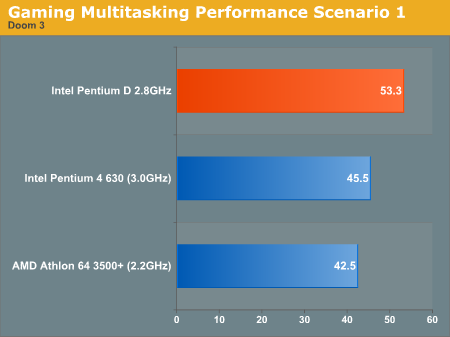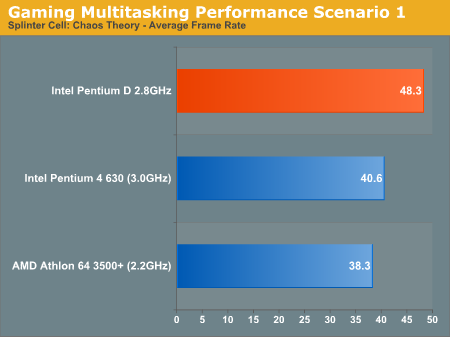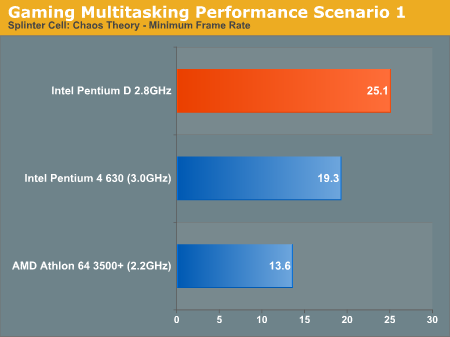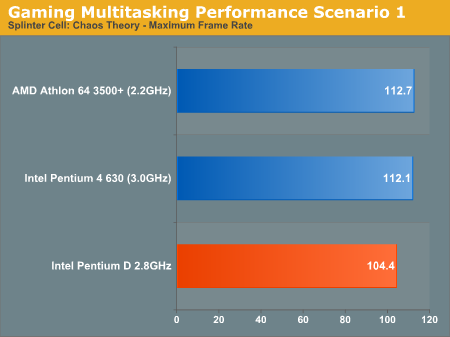Intel Dual Core Performance Preview Part II: A Deeper Look
by Anand Lal Shimpi on April 6, 2005 12:23 PM EST- Posted in
- CPUs
Gaming Multitasking Scenario 1: Heavy Downloading
In the first article, we ran under the assumption that gamers wanted to have as little running in the background while playing a game. While that ended up being true for a lot of folks, we also received quite a bit of feedback asking for some pretty intense multitasking tests while gaming. The requests were far more intense than even the most strenuous setup that we came up with, but because of the demand for such benchmarks, we spent some time putting a few together. Note that this is by no means supposed to be an exhaustive comparison of all gaming scenarios. We are working on creating more and we apologize if your desired scenario didn't make it into this review, but keep sending in suggestions on how you play and we'll do our best to model some benchmarks after how you use your computer.
The first test basically performs all of the tasks from our first Multitasking Scenario, with the exception of DVD Shrink. We have Firefox loaded, but with all 12 tabs from the third test, iTunes is running and playing a playlist, and Newsleecher is downloading headers. We kept Newsleecher in this test simply because it's the best way for us to be able to have a fairly CPU/disk intensive downloading task running in the background while still maintaining some semblance of repeatability. So, replace Newsleecher with BitTorrent or any other resource-consuming downloading that you may be doing and you're good to go.
Of course, Norton AntiVirus 2004 and Microsoft's AntiSpyware Beta were also running in the background.
First, we ran our Doom 3 benchmark:

The tables have now been turned. While the Athlon 64 held a 30% lead with no multitasking, it's now outpaced by both Intel processors, with the Pentium D holding a 25% performance advantage.
It's no surprise that having two cores yield less of a performance impact to having more applications run in the background.
Doom 3 was actually quite playable on both machines; although, loading the game and the levels took a lot longer on the A64, and there's a lot of stuttering during the actual game.
The Pentium 4 platform was quite a bit better, but there is a definite reduction in performance. Obviously, the Pentium D did the best out of the group, but you still notice the performance drop.
Next, we ran the Splinter Cell: Chaos Theory benchmark:



Once again, the Pentium D is ahead of the Athlon 64, but the improvement in minimum frame rates is particularly impressive. The Pentium D offers twice the minimum frame rate of the Athlon 64 in this scenario.










106 Comments
View All Comments
saratoga - Friday, April 8, 2005 - link
#90:HT is the same thing as SMT. You can thank Intel's marketing for that one.
Reflex - Friday, April 8, 2005 - link
#93: Intel has labeled it as SMT, however there is another name for what they are doing(that I cannot remember at the moment). What they are calling SMT is nowhere even close to solutions like Power.That aside, the implementation Intel has chosen is designed to make up for inefficiencies in the Prescott pipeline, such a implementation would make zero sense on the Athlon architecture, it does not share the same inefficiencies that the P4 design has. It would actually harm rather than help performance.
True SMT is not a 'bolt on' feature. Its something that has to be planned for from the very beginning of the CPU design cycle. You could not in any way add it to the current Athlon design and gain any performance. Whatever their next generation is may include it, it depends on what direction they decide to go, but you will not see it on the current generation, and thats actually a good thing as it would be purely a marketing move.
eeceret - Friday, April 8, 2005 - link
As always a very interesting article, one thing comes to mind though... In the gaming multitasking tests you adjusted the priority of the DVD Shrink process to see the effect on gaming performance. What I was wondering is if you could take a look at what effect explicitly binding the processes to seperate cores (processor affinity) has on gaming performancedefter - Friday, April 8, 2005 - link
Hyperthreading IS SMT. SMT stands for symmetric multithreading (ability to run two or more threads at once and this is exactly what hyperthreading does.Of course, CPUs from different manufacturers have vastly different internal structures, thus also the SMT is implemented differently.
"Intel's next major IA-32 processor release, codenamed Prescott, will include a feature called simultaneous multithreading (SMT)"
http://arstechnica.com/articles/paedia/cpu/hyperth...
tynopik - Friday, April 8, 2005 - link
and of course that's just the net part, don't want to leave out other background tasks like that resource sucker outlook and playing flac/ape filestynopik - Thursday, April 7, 2005 - link
to get repeatable multi-tasking/ncq benches, anand is going to have to bite the bullet and setup a full-blown network simulation:1: an nntp server
2. a bittorrent swarm
3. an irc server
with this setup, you can test these multi-tasking scenarios that seem more reasonable:
1. firewall (a pig like zonealarm)
2. pulling news articles with either 2 clients or 1 client with 2 threads (writing to different places on hd simultaneously)
3. about 10 torrents where it is BOTH downloading and uploading (so pulling from a gazillion different places on hd at once)
4. mirc with about 5 open channels and some scripts (like filters). At least one channel should be very high traffic (like #mp3passion on undernet)
5. icq
6. running all this with software raid 5
this would represent a typical background load, and then you can benchmark foreground tasks to see how much they are affected by what's going on in the background (specifically ncq could be tested by seeing how long it takes to copy a file from one partition to another under these circumstances)
Reflex - Thursday, April 7, 2005 - link
Just to be clear: SMT is NOT the same thing as HyperThreading. They go about what they are doing in radically different ways. The only similarity is in the CPU being able to execute two simultanious threads. How it goes about that though is implemented completely differently.Reflex - Thursday, April 7, 2005 - link
"#47, if HT is simply a "bandaid", then why is AMD the only major CPU vendor not using it? IBM uses it heavily in their Power5, Sun is making their next CPUs (Niagra) very highly SMT (same thing as HT). Arguably, both of those architectures have much more shallow pipelines than the P4, yet see reason to provide SMT. AMD is the only holdout."The SMT used in IBM's Power series is completely different from what Intel is doing with the P4 design. The only similarity is the fact that two threads can be run at once, the implementation has nothing even close to the same however. I do not have details on Sun's implementation, but I would assume it will be closer to IBM's than Intel's implementation considering the market they are targetting. The Power architecture was designed from the ground up to use SMT, it wasn't a tacked on feature, and you get considerably more of a performance boost in most scenerios with it than you would ever see with HT on Intel.
The Athlon64 architecture was not designed with SMT or HT in mind, it was designed around two physical cores. So adding HT to it would do very little, and SSE3(which mostly optimizes HT style multithreading) does almost nothing on the K8 architecture.
Not every feature would help every CPU design, it all depends on what was taken into account when the design was made. Power has some limitations you do not see on x86(in order execution for example), and x86 has challenges you do not see on Power. The multi-threading implementations are similarly different and not comparable. In the x86 world, HT makes sense on Intel in some situations(not always). It makes no sense on AMD and would likely result in performance drops rather than gains. It certainly would not improve performance in any way as the core does not often have idle units or execution steps due to its design.
Icehawk - Thursday, April 7, 2005 - link
"I'm also curious to see what effects RAID would have on testing striped setups."Uh, delete the "striped setups" from the end ;)
Can we please, please get some kind of short-term editing abilities here?
Icehawk - Thursday, April 7, 2005 - link
So you'd rather wait for information than recieve it now?Anand clearly shows that dual core is only a good choice now IF you use it in scenarios where it can run multiple applications. Otherwise, single core chips are still the better choice. So i don't see the marketing hype you are referring to. Basically we've been told now for quite a few years that multi-taskers can benefit from multiple CPUs but the costs have been prohibitive. Now it looks like within the next year a 2 CPU machine will cost no more than previous single core processors.
Thanks Anand for helping us out in planning for the future! The DVDShrink stuff was very interesting to me as was the NCQ information - makes switching to SATA drives a bit more appealing to me considering my usage profile.
I just recently went from 1.4 k7->3.2 P4 w/HT so I'm pretty happy at this point. It does look like a dual core system *might* allow me to get rid of my second box (the 1.4 K7) which would save me money in the long run - one less PC to power up and cool off. My home office requires year round A/C to cool my 2 21" CRTs and 2 PCs...
I'm also curious to see what effects RAID would have on testing striped setups. I'm very curious if a RAID5 type of setup with NCQ and a dual-core might make chores like encoding & gaming realistic - it sounds like from the review that at this point I/O may cause hiccups even when the processor still has headroom.